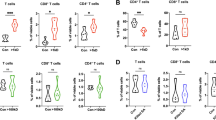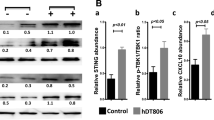Abstract
Currently, therapy for squamous cancer (SqC) is unsatisfactory. Staphylococcal enterotoxin B (SEB) has strong immune regulatory activity. This study tests the hypothesis that SEB enforces the effect of immunotherapy on SqC growth in a mouse model. C3H/HeN mice and the SqC cell line squamous cell carcinoma VII were used to create an SqC mouse model. Immune cell assessment was performed by flow cytometry. Real-time RT-PCR and western blotting were used to evaluate target molecule expression. An apoptosis assay was used to assess the suppressive effect of T helper-9 (Th9) cells on the SqC cells. The results showed that immunotherapy consisting of SEB plus SqC antigen significantly inhibited SqC growth in the mice. The frequency of Th9 cells was markedly increased in the SqC tissue and mouse spleens after treatment. SEB markedly increased the levels of signal transducer and activator of transcription 5 phosphorylation and the expression of histone deacetylase-1 (HDAC1) and PU.1 (the transcription factor of the interleukin 9 (IL-9) gene) in CD4+ T cells. Exposure to SqC-specific Th9 cells markedly induced SqC cell apoptosis both in vitro and in vivo. In conclusion, the administration of SEB induces Th9 cells in SqC-bearing mice, and theseTh9 cells inhibit SqC growth.
This is a preview of subscription content, access via your institution
Access options
Subscribe to this journal
Receive 12 digital issues and online access to articles
$119.00 per year
only $9.92 per issue
Buy this article
- Purchase on Springer Link
- Instant access to full article PDF
Prices may be subject to local taxes which are calculated during checkout






Similar content being viewed by others
References
Winquist E, Al-Rasheedy I, Nichols AC, Palma DA, Stitt L . Temporal changes in the efficacy of chemotherapy for recurrent or metastatic squamous cell carcinoma of the head and neck: a systematic review and meta-analysis. Cancer Treat Rev 2014; 40: 1073–1079.
Cai Y, Li J, Lu A, Zhong W, Gao J, Zheng Y et al. Increased serum levels of macrophage inflammatory protein-3 alpha and cystatin a predict a poor prognosis of nasopharyngeal carcinoma. Medicine (Baltimore) 2014; 93: e123.
Homma A, Hayashi R, Matsuura K, Kato K, Kawabata K, Monden N et al. Lymph node metastasis in t4 maxillary sinus squamous cell carcinoma: incidence and treatment outcome. Ann Surg Oncol 2014; 21: 1706–1710.
Mahalingappa YB, Khalil HS . Sinonasal malignancy: presentation and outcomes. J Laryngol Otol 2014; 128: 654–657.
Denaro N, Merlano MC, Russi EG, Lo Nigro C . Non coding RNAs in head and neck squamous cell carcinoma (HNSCC): a clinical perspective. Anticancer Res 2014; 34: 6887–6896.
Viet CT, Dang D, Achdjian S, Ye Y, Katz SG, Schmidt BL . Decitabine rescues cisplatin resistance in head and neck squamous cell carcinoma. PLoS One 2014; 9: e112880.
Tewari KS, Monk BJ . New strategies in advanced cervical cancer: from angiogenesis blockade to immunotherapy. Clin Cancer Res 2014; 20: 5349–5358.
Lee AS . Glucose-regulated proteins in cancer: molecular mechanisms and therapeutic potential. Nat Rev Cancer 2014; 14: 263–276.
Wang BQ, Zhang CM, Gao W, Wang XF, Zhang HL, Yang PC . Cancer-derived matrix metalloproteinase-9 contributes to tumor tolerance. J Cancer Res Clin Oncol 2011; 137: 1525–1533.
Purwar R, Schlapbach C, Xiao S, Kang HS, Elyaman W, Jiang X et al. Robust tumor immunity to melanoma mediated by interleukin-9-producing T cells. Nat Med 2012; 18: 1248–1253.
Farahani R, Sherkat R, Hakemi MG, Eskandari N, Yazdani R . Cytokines (interleukin-9, IL-17, IL-22, IL-25 and IL-33) and asthma. Adv Biomed Res 2014; 3: 127.
Vegran F, Apetoh L, Ghiringhelli F . Th9 cells: a novel CD4 T-cell subset in the immune war against cancer. Cancer Res 2015; 75: 475–479.
Sharma P, Wang N, Kranz DM . Soluble T cell receptor Vβ domains engineered for high-affinity binding to staphylococcal or streptococcal superantigens. Toxins (Basel) 2014; 6: 556–574.
Yang PC, Xing Z, Berin CM, Soderholm JD, Feng BS, Wu L et al. TIM-4 expressed by mucosal dendritic cells plays a critical role in food antigen-specific Th2 differentiation and intestinal allergy. Gastroenterology 2007; 133: 1522–1533.
Yang SB, Li TL, Chen X, An YF, Zhao CQ, Wen JB et al. Staphylococcal enterotoxin B-derived haptens promote sensitization. Cell Mol Immunol 2013; 10: 78–83.
Zhao P, Bu X, Wei X, Sun W, Xie X, Li C et al. Dendritic cell immunotherapy combined with cytokine-induced killer cells promotes skewing toward Th2 cytokine profile in patients with metastatic non-small cell lung cancer. Int Immunopharmacol 2015; 25: 450–456.
Bassil R, Orent W, Olah M, Kurdi AT, Frangieh M, Buttrick T et al. BCL6 controls Th9 cell development by repressing Il9 transcription. J Immunol 2014; 193: 198–207.
Nielsen M, Svejgaard A, Ropke C, Nordahl M, Odum N . Staphylococcal enterotoxins modulate interleukin 2 receptor expression and ligand-induced tyrosine phosphorylation of the Janus protein-tyrosine kinase 3 (Jak3) and signal transducers and activators of transcription (Stat proteins). Proc Natl Acad Sci USA 1995; 92: 10995–10999.
Busbee PB, Nagarkatti M, Nagarkatti PS . Natural indoles, indole-3-carbinol and 3,3′-diindolymethane, inhibit T cell activation by staphylococcal enterotoxin B through epigenetic regulation involving HDAC expression. Toxicol Appl Pharmacol 2014; 274: 7–16.
Xu M, Nie L, Kim SH, Sun XH . STAT5-induced Id-1 transcription involves recruitment of HDAC1 and deacetylation of C/EBPbeta. EMBO J 2003; 22: 893–904.
Dardalhon V, Awasthi A, Kwon H, Galileos G, Gao W, Sobel RA et al. IL-4 inhibits TGF-beta-induced Foxp3+ T cells and, together with TGF-beta, generates IL-9+ IL-10+ Foxp3(-) effector T cells. Nat Immunol 2008; 9: 1347–1355.
Staudt V, Bothur E, Klein M, Lingnau K, Reuter S, Grebe N et al. Interferon-regulatory factor 4 is essential for the developmental program of T helper 9 cells. Immunity 2010; 33: 192–202.
Vegran F, Berger H, Boidot R, Mignot G, Bruchard M, Dosset M et al. The transcription factor IRF1 dictates the IL-21-dependent anticancer functions of TH9 cells. Nat Immunol 2014; 15: 758–766.
Veldhoen M, Uyttenhove C, van Snick J, Helmby H, Westendorf A, Buer J et al.Transforming growth factor-beta ‘reprograms’ the differentiation of T helper 2 cells and promotes an interleukin 9-producing subset. Nat Immunol 2008; 9: 1341–1346.
Liao W, Spolski R, Li P, Du N, West EE, Ren M et al. Opposing actions of IL-2 and IL-21 on Th9 differentiation correlate with their differential regulation of BCL6 expression. Proc Natl Acad Sci USA 2014; 111: 3508–3513.
Dhaliwal W, Kelly P, Bajaj-Elliott M . Differential effects of Staphylococcal enterotoxin B-mediated immune activation on intestinal defensins. Clin Exp Immunol 2009; 156: 263–270.
Liu JN, Shin YS, Yoo HS, Nam YH, Jin HJ, Ye YM et al. The prevalence of serum specific IgE to superantigens in asthma and allergic rhinitis patients. Allergy Asthma Immunol Res 2014; 6: 263–266.
Orfali RL, Sato MN, Santos VG, Titz TO, Brito CA, Duarte AJ et al. Staphylococcal enterotoxin B induces specific IgG4 and IgE antibody serum levels in atopic dermatitis. Int J Dermatol 2015; 54: 898–904.
Acknowledgements
This study was supported by grants from the Innovation of Science and Technology Commission of Shenzhen Municipality (JCYJ20140418095735538; JCYJ20120613161724279; JCYJ20120613172559904; JCYJ20130329110735981; JCYJ20120613173233810); International Collaboration Project (GJHZ20130408174112021); and the National Nature Science Foundation and China (81373176).
Author information
Authors and Affiliations
Ethics declarations
Competing interests
None to declare.
Additional information
Supplementary information of this article can be found on the Cellular & Molecular Immunology’s website (http://www.nature.com/cmi).
Supplementary information
Rights and permissions
About this article
Cite this article
Miao, BP., Zhang, RS., Sun, HJ. et al. Inhibition of squamous cancer growth in a mouse model by Staphylococcal enterotoxin B-triggered Th9 cell expansion. Cell Mol Immunol 14, 371–379 (2017). https://doi.org/10.1038/cmi.2015.88
Received:
Revised:
Accepted:
Published:
Issue Date:
DOI: https://doi.org/10.1038/cmi.2015.88
Keywords
This article is cited by
-
Potential effects of gut microbiota on host cancers: focus on immunity, DNA damage, cellular pathways, and anticancer therapy
The ISME Journal (2023)
-
PU.1 negatively regulates tumorigenesis in non-small-cell lung cancer
Medical Oncology (2023)
-
IL-9 and IL-9-producing cells in tumor immunity
Cell Communication and Signaling (2020)
-
TH9 cells in anti-tumor immunity
Seminars in Immunopathology (2017)



